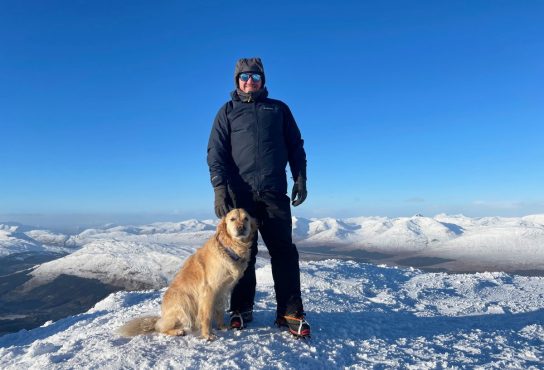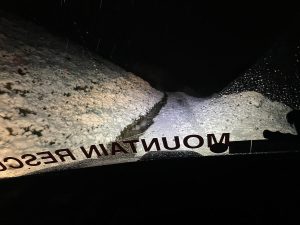
01674 672 657 (Mon-Thurs 8am-5pm & Fri 8am-1pm)


In our guest journal this week, we caught up with Mike McLaggan from Tayside Mountain Rescue.
We’re thrilled to share insights from Mike McLaggan, a dedicated member of Tayside Mountain Rescue and Scottish Mountain Rescue Equipment Officer. In this exclusive Q&A, Mike talks about what inspired him to join the team, the challenges of rescue work in Scotland’s rugged terrain and how technology is transforming mountain safety.
From practical advice for hikers and climbers to the rewarding experience of saving lives, Mike’s words remind us of the importance of preparation, teamwork and resilience in the great outdoors.

What inspired you to join Tayside Mountain Rescue?
I have been lucky to have spent many years in the outdoors both for leisure and working professionally therefore understand things can go wrong no matter who you are. MRT members are all keen mountaineers and it’s this kindred spirt that inspires many of us to help out and to give something back to the community.

As an outdoor enthusiast, has your personal outdoor perspective changed since becoming a volunteer?
As a Rescue team member, you often see the other side when things go wrong. It does make you very aware of the dangers of the environment and I suppose having this unique outdoor perspective drives home the urgency to help people who are in need.
What’s the most challenging aspect of mountain rescue work?
Much of our work takes place in poor weather, at night and in very challenging places such as steep ground, cliffs, crags and gorges.Sometimes the remoteness of the rescue can also be challenging in terms of communication,logistics and accessibility.

Is there a rescue story that has stayed with you?
I think most incidents stay with you in some shape or form and it’s important that we learn and evolve from our work. All SMR volunteers have access to a variety of post incident support and the collective camaraderie of the wider team.
What advice would you give to hikers and climbers to stay safe?
It’s something that we get asked a lot.There are many factors that come into play regarding safety on the mountains! Experience,fitness,weather,time factors,proper footwear / clothing / equipment, route choice and a multitude of other things. Planning and preparation should be at the forefront of people’s minds before they venture out and they need seriously consider all the variables that may come their way on the hill. Many incidents happen due to people not being prepared / equipped or having the ability and skills to deal with a situation on a mountain. It’s important that people heading to the mountains get their information from reliable and proper sources which include weather and avalanche/snow conditions. In Scotland we have a brilliant variety of guidebooks for both hillwalking and climbing which give detailed information of the mountain routes. There are some good instruction handbooks and a great selection of top-quality training providing mountain instruction for all skill levels.
How has technology changed the way you operate?
Yes,it has and is continually evolving! The mobile phone network is improving which makes communication far easier for the rescue teams. Drones are frequently used now and in difficult searches can cover vast amounts of terrain. Mobile internet platforms such as “Starlink” can be deployed and give teams internet access even in the most remote places. Radio and repeater systems are evolving giving improved hill communication between team members and base control. New 4×4 vehicle technology and the use of ATVs can speed up a rescue and be a massive factor in deploying a team and saving lives. We continually seek out and train with the most up to date equipment. Whether this is technical, medical or avalanche. SMR is at the forefront of these rescue techniques internationally. GPS enabled smart phones to have really helped in terms of locating misplaced people and if used correctly along with the correct mapping software really assist in mountain navigation for us all. However, everyone should still carry a map / compass and know how to use them as battery life on a mobile phone will drain in cold weather.
What’s the most rewarding part of being part of the TMR team?
I’m speaking personally but sure other will think the same. It’s very much about using your own experience to help others which on some occasions can be the worst day of their life. It’s also about giving something back to the environment which has given me so much over the years. I take my hat off to my fellow team members who do this important work in such a self-less manner.

What message would you like to share with anyone who is considering becoming a Mountain Rescue volunteer?
There are a few things but most of all you really need to want to do it and be a very happy to be part of a team. People need to have good mountain skills / experience before joining a team and be willing to learn new rescue skills and techniques. Be prepared to donate lots of your time and have a supportive family and employer. For example,Tayside MRT has already had 65 call outs in 2025 so if you add in a monthly exercise, base nights, medical nights, SMR courses and fund-raising events it can very quickly add up to 50+ volunteering days per year.

Thanks so much to Mike for sitting down to answer these questions for us. We hope you find some inspiration in here to head outdoors and explore what’s on your doorstep – safely and responsibly of course!
Some useful information links below:
https://www.mountaineering.scot for information for climbers / hillwalkers
https://www.mwis.org.uk Mountain Weather Information Service
https://www.sais.gov.uk Scottish Avalanche Information Service
https://www.scottishmountainrescue.org for information on Scottish Mountain Rescue
https://taysidemrt.org for information on Tayside Mountain Rescue
